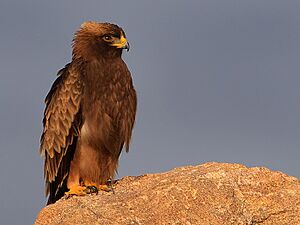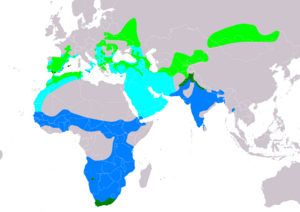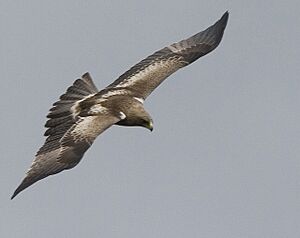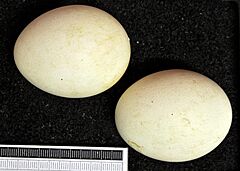Booted eagle facts for kids
The booted eagle (Hieraaetus pennatus) is a medium-sized bird of prey. It's a type of eagle that belongs to the Accipitridae family. These eagles are mostly migratory, meaning they travel long distances. They are found across Europe and Asia, and they spend their winters in warmer parts of Africa and Asia. There's also a small group that lives and breeds in southwestern Africa.
Quick facts for kids Booted eagle |
|
|---|---|
 |
|
| A dark morph wintering in India | |
| Conservation status | |
| Scientific classification | |
 |
|
| Range of H. pennatus Breeding Resident Passage Non-breeding | |
| Synonyms | |
|
Contents
Taxonomy
The booted eagle was first officially described in 1788 by a German scientist named Johann Friedrich Gmelin. He gave it the scientific name Falco pennatus. The name pennatus comes from Latin and means "feathered," which refers to the feathers on its legs.
Today, the booted eagle is placed in the genus Hieraaetus. This name combines two Ancient Greek words: hierax (meaning "hawk") and aetos (meaning "eagle"). Scientists sometimes move species between different groups as they learn more from DNA research. For a while, some thought it might belong in the Aquila genus, but most experts now agree it fits best in Hieraaetus.
Description
The booted eagle is a small eagle, similar in size to a common buzzard. Males usually weigh about 510 to 770 grams (1.1 to 1.7 pounds). Females are a bit heavier, weighing around 840 to 1025 grams (1.8 to 2.3 pounds). They are about 40 cm (16 inches) long and have a wingspan of 110 to 132 cm (43 to 52 inches).
These eagles come in two main color forms, called "morphs."
- Pale morph: These birds are mostly light grey with a darker head and flight feathers.
- Dark morph: These birds have mid-brown feathers with dark grey flight feathers.
In some areas, like South Africa, about 20% of the booted eagles are the dark morph. In other places, like Russia, the dark morph is much more common. Booted eagles usually fly alone or in pairs. Their call is a sharp kli-kli-kli.
Distribution and habitat
Booted eagles live in many different places around the world. They breed in southern Europe, North Africa, and across Asia. They also have breeding groups in western South Africa and Namibia.
The eagles from Europe and Asia are migratory. They fly south to Sub-Saharan Africa and South Asia for the winter, from November to February. The small groups in southern Africa, however, tend to stay in one place all year.
These birds like to live in wooded areas, often in hilly countryside with some open spaces. They build their nests in rocky areas. When they migrate, they can be found in almost any habitat, except for very dense forests. In Europe and Asia, they often nest in coniferous or deciduous trees.
Southern African populations
Scientists believe there might be three different groups of booted eagles in Southern Africa.
- One group breeds in the southwestern Cape region of South Africa. They arrive in early August, lay eggs in September, and leave by March. They migrate north, with some possibly spending winter in Namibia.
- A small breeding group has also been seen in Northern Namibia.
- A third group is thought to migrate south from Europe and North Africa for the summer, but this hasn't been fully proven.
These Southern African eagles are the same species as those in Europe and Asia. In South Africa, they often nest on rocky cliffs in ravines and gorges. However, some have been seen nesting in trees like Euphorbias. They are most common in the low shrublands of the Fynbos and Karoo regions.
Behaviour and ecology
Booted eagles often fly at lower heights, which makes them easier to spot. However, the dark morph can sometimes be mistaken for other medium-sized birds of prey in the area.
Diet and hunting
The booted eagle usually hunts while flying. It dives down quickly with its wings folded and feet ready to grab its prey. They hunt small mammals, reptiles, and birds. In Southern Africa, birds are the most common prey they catch. While some suggest frogs are important to their diet, this hasn't been seen in the Southern African groups. Studies in southwestern South Africa showed they mainly eat birds, lizards, and rodents.
Breeding
Booted eagles lay 1 to 2 eggs. They build their nests from sticks and line them with green leaves. Nests are usually in a tree or on a rocky cliff. Sometimes, they take over an old nest from another large bird, like a black kite or grey heron.
The female eagle sits on the eggs for about 45 days. During this time, the male brings her food. After the chicks hatch, the female guards them, and the male continues to bring all the food. The young eagles are ready to fly after 70 to 75 days. Booted eagles usually stay with the same partner for life and perform amazing flight displays to attract each other.
Southern Africa breeding
The eagles that breed in the Cape region of South Africa usually start nesting soon after they arrive in August. They build their nests on cliff ledges, which is different from many booted eagles in Europe and Asia. The eggs hatch after about 40 days, and the chicks stay in the nest for around two months. Studies in South Africa found that these eagles typically nest on cliffs about 60 meters (200 feet) high. They usually raise two chicks successfully. The eggs are often white, sometimes with red spots.
Northern African breeding
Booted eagles also migrate to parts of North Africa during the European winter and breed there. A study in Algeria found that these birds incubate their eggs for 33 to 38 days. Like other populations, they most often lay two eggs (about 67.6% of the time).
Conservation and threats
There isn't a lot of research on this migratory species. The populations in Southern Africa were only discovered in the 1980s. This might mean they moved there because of changes in climate or environment. Changes in how humans use land might also have affected their migration patterns. It's also thought that these eagles have been hard to study in Southern Africa because their nesting sites are often hidden and far away. More research is needed to fully understand these birds and how to protect them.
Images for kids







